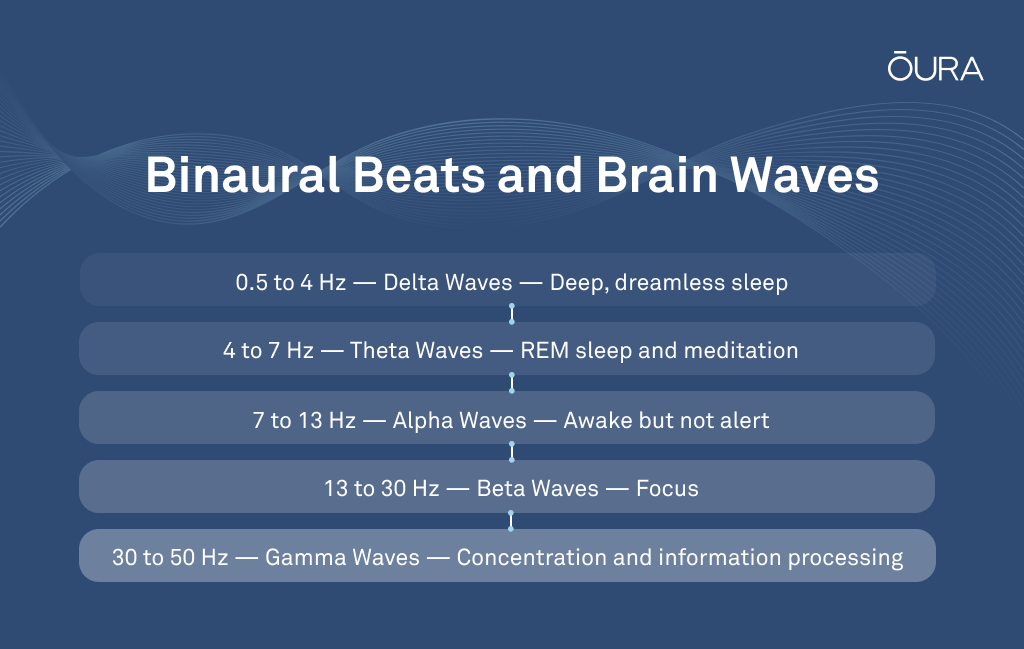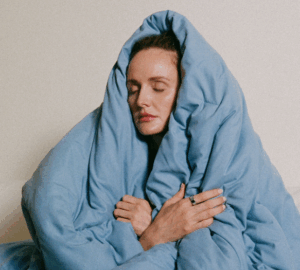- Binaural beats and solfeggio frequencies are two popular forms of sound therapy that can help improve sleep and reduce stress, but when it comes to binaural beats vs solfeggio frequencies — what’s the best frequency for sleep?
- Binaural beats create an auditory illusion by playing different tones in each ear, while solfeggio frequencies consist of single tones with specific health benefits.
- Oura members can explore various sleep sounds and use biofeedback data in the Oura App to determine which type of meditation or sound therapy works best for their sleep quality and overall wellness.
You might have heard that certain sounds have healing frequencies that can help you get a good night’s sleep. Binaural beats and solfeggio frequencies are two popular types of healing sounds.
Binaural beats are an auditory illusion created by playing different tones in different frequencies in each ear, while solfeggio frequencies are a set of nine tones that many believe have spiritually enhancing properties.
| Member Tip: Access a growing library of sleep sounds in the Explore Tab, ranging from guided breathing exercises to mindfulness meditations. Use the biofeedback data after each session and your Sleep Score to see what kind of meditation works best for you and incorporate it into your bedtime routine. |
Below, we’ll explore each type of healing sound and determine which, binaural beats vs solfeggio frequencies, is more effective for you.
Binaural Beats vs. Solfeggio Frequencies: What’s the Difference?
The main difference between binaural beats and solfeggio frequencies is that binaural beats contain two different tones plus a third ‘phantom’ tone, whereas solfeggio frequencies only contain one tone.
Plus, because binaural beats stimulate the left and right ears, they’re only effective if you listen to them in headphones, but solfeggio tones are just as effective when played through a speaker.
Finally, binaural beats contain isochronic tones that create a rhythmic pulsing sound, whereas solfeggio frequencies produce a more even sound.
What Are Binaural Beats?
Binaural beats consist of two different tones at different frequencies in different ears to create the illusion of a third tone. The brain processes the difference between the two tones it’s actually hearing to create this imaginary sound.
Binaural beats are commonly used in five different frequencies, measured in hertz (Hz), which represents the number of sound wave cycles occurring per second. These frequencies correspond to each of the five brain wave states.
0.5 to 4 Hz — Delta Waves
Your brain produces delta waves when you’re in a deep, dreamless sleep.
4 to 7 Hz — Theta Waves
Theta waves happen when you’re in REM sleep or a deep state of meditation or relaxation.
7 to 13 Hz — Alpha Waves
Alpha waves occur when you’re awake but not alert, like when you first wake up in the morning or when you go to bed at night.
13 to 30 Hz — Beta Waves
You experience beta brain waves when you’re focusing on tasks and the outside world as you go about your day.
30 to 50 Hz — Gamma Waves
Gamma — the fastest brain waves — mainly occur when you’re concentrating and processing information.

There’s ample evidence to suggest that binaural beats may help with sleep. One study found that binaural beats reduce stress, another concluded they alleviate anxiety, and a third found they boost focus and concentration.
One way to measure your stress levels is to monitor your heart rate variability (HRV). A higher HRV indicates a relaxed state, while a lower HRV is a sign of stress.
| Member Tip: Oura members can track their HRV in the Oura App and take steps to alleviate stress — such as listening to binaural beats — when necessary. |
While alleviating stress and anxiety alone can improve sleep quality, another study found that 3 Hz binaural beats induce delta activity in the brain, which may help you fall into deep sleep more easily. Additionally, a study of young elite soccer players found binaural beats from 2 Hz to 8 Hz improved their sleep quality.
READ MORE: Can Binaural Beats Help You Sleep Better?
What Are Solfeggio Frequencies?
The origins of the solfeggio frequencies are unknown and somewhat esoteric in nature. Many people attribute these sound frequencies to a medieval Italian music theorist and Benedictine monk, Guido d’Arezzo, whose Gregorian chants incorporate the original six solfeggio scales. However, others believe they have much older roots in the Sanskrit mantras of ancient India.
Three additional tones were subsequently added to form the nine-tone solfeggio scale we use today. Like binaural beats, each frequency is said to achieve a specific benefit. Although scientific evidence to back up most of these claims is lacking, certain solfeggio frequencies have been studied and found to have healing benefits.
174 Hz
This frequency is said to provide pain relief and ease physical tension in the body. Although there is little evidence to prove this, one study found that listening to low-frequency sounds — like solfeggio frequencies — reduced pain in fibromyalgia patients.
285 Hz
Some believe that 285 Hz restores tissues, strengthens the immune system, and balances the root chakra.
396 Hz
This frequency is said to help release fear, guilt, doubt, and negative thoughts.
417 Hz
417 Hz is believed to clear negative energy from your environment, release shame and anger, and balance the sacral chakra. Some say it’s the best solfeggio tone to listen to for sleep.
432 Hz
432 Hz is also known as the “Heartbeat of the Earth” because of its alignment with the Schumann Resonance, the frequency of the Earth’s magnetic field.
A 2019 study from Italy found that listening to this frequency lowered participants’ blood pressure and heart rate and slowed their breathing, indicating that it may induce a relaxation response.
528 Hz
Fun fact: John Lennon’s ‘Imagine’ was written in 528 Hz, also known as the “love frequency” or “miracle tone.”
One study found that listening to this frequency reduced cortisol, the stress hormone, and alleviated feelings of stress and anxiety in participants.
629 Hz
Some believe that this frequency restores harmony in relationships and helps with expressing emotions. It’s also associated with the heart chakra.
741 Hz
741 Hz is believed to remove emotional blockages, balance the throat chakra, and remove toxicity from your environment.
852 Hz
The highest solfeggio frequency is said to help with accessing deeper states of consciousness and awakening intuition.
READ MORE: The 9 Solfeggio Frequencies and Their Benefits
Binaural Beats vs. Solfeggio Frequencies: Which Is Better For Sleep?
As we have seen, the science indicates that both binaural beats and solfeggio frequencies affect the body and mind in ways that benefit sleep. For example, low-frequency binaural beats (roughly 2 Hz to 7 Hz) can induce theta brain waves that put you in a state of relaxation.
Of the solfeggio frequencies, only 528 Hz and 432 Hz have proven effects on your body’s relaxation responses. However, a 2022 study of university students found that low-frequency music alleviates stress, indicating that all low-frequency binaural beats and solfeggio sounds probably benefit sleep in their own ways.
FAQs About Binaural Beats, Solfeggio Frequencies, and Sleep
What is the best frequency for sleep?
The best frequency for sleep is often linked to low ranges that promote relaxation. Delta waves (0.5–4 Hz) created by binaural beats may help you reach deep sleep, while solfeggio tones like 432 Hz and 528 Hz have been studied for lowering stress and promoting calm.
Binaural beats vs solfeggio frequencies — which is better for sleep?
When it comes to binaural beats vs solfeggio frequencies, both may improve sleep quality. Binaural beats in the delta or theta range are shown to encourage restorative sleep, while solfeggio frequencies such as 528 Hz (the “love frequency”) can reduce stress hormones and promote relaxation.
What Hz is best for sleep?
If you’re wondering what Hz is best for sleep, research suggests that 2–7 Hz binaural beats can help induce theta brain waves for relaxation, and 432 Hz or 528 Hz solfeggio tones may support stress relief and better rest.
Can I listen to solfeggio frequencies while sleeping?
Yes, you can listen to solfeggio frequencies while sleeping. Many people use calming tones like 432 Hz or 528 Hz throughout the night to reduce stress and improve sleep quality.










